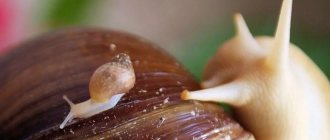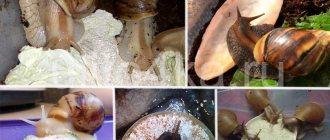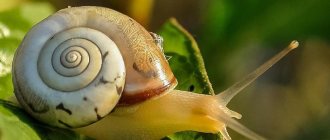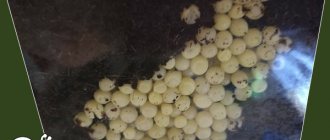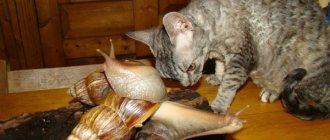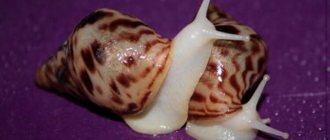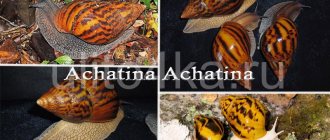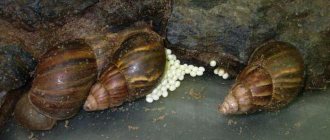Home » Useful Information
The African snail Achatina is an exotic pet. With proper care, the mollusk grows to enormous sizes. It is important for breeders to know what to feed Achatina at home in order to provide them with all the nutrients necessary for life and growth.
- 1.1 What can you feed Achatina
1.1.1 Video: greens in the diet of Achatina
- 1.1.2 Video: feeding Achatina, nutritional supplements
- 2 Achatina diet at home
- 3 Vitamins and minerals
- 4 Sources of calcium in the snail's diet
- 5 How often should you water shellfish?
- 6 What to feed newborns and small snails
6.1 Video: reproduction, laying, how to care for cubs
What do Achatina eat?
African snails feed on leaves, shoots and fruits of various plants. Many species are natural pests. They can cause significant damage to crops by eating them. However, in Europe and Russia, Achatina does not pose a threat to established ecosystems due to climate conditions.
Achatina are vegetarians by nature. Despite their homeland in Africa, they love our native fruits and vegetables, and the list of allowed foods is quite long. In a terrarium they happily eat a variety of local vegetables, fruits and herbs.
Many of them include sweet fruits in their snail food. In general, shellfish can choose one food item and eat it willingly, but they vary their food intake. Includes fiber, minerals (calcium) and protein. Greens, dandelion leaves, etc. are especially useful. Let's find out more about this.
Vegetables and fruits
Before giving fruits and vegetables to Achatina, wash them and cut them into small pieces. Grate pumpkin, zucchini and other dense vegetables using a small snail grater. All products should be at room temperature.
Achatina loves the sweet pulp of bananas, but babies should not eat it. They bite into the pulp and cannot get out of it. Snails quickly get used to bananas and do not want to eat another one. Therefore, it is better to give bananas once or twice a week.
Avocados, peaches, cucumbers and non-acidic tomatoes are delicacies for Achatina. They eat these fruits with great pleasure.
Classic vegetables (carrots, beets, cabbage of all varieties, sweet peppers) can be given daily without restrictions.
Any pumpkin can also be added to your diet. The potassium, iron, vitamins and fiber found in watermelon will provide benefits on their own.
A few words of caution. Be aware that high nitrate levels can kill the slug. Unscrupulous melon growers often use nitrates to force them to ripen faster. Choose watermelons and other squashes that are naturally ripened without the use of nitrates.
Fruits that can be eaten by slugs:
- apricots;
- avocado;
- a pineapple;
- watermelon;
- bananas;
- cherry
- pears
- melon;
- zucchini;
- carrot; carrot;
- nectarines;
- cucumbers;
- squash;
- beet;
- Bell pepper;
- plums;
- tomatoes;
- pumpkin;
- persimmon
- zucchini;
- apples.
Greens and herbs
All the succulent table greens that snails love. It can be parsley, celery, dill, dandelion, nettle, plantain.
What types of greens are good for Achatina:
- White cabbage;
- Brussels sprouts;
- Cauliflower;
- clover;
- nettle;
- plantain leaves;
- lettuce leaves
- birch leaves;
- oak leaves;
- linden leaves;
- Raspberry leaves;
- Currant leaves;
- burdock;
- alfalfa;
- bittercress;
- dandelion
- parsley;
- chamomile;
- celery;
- dill;
- spinach.
Berries
Grape
The debate about grapes has been going on for a long time. They came to the conclusion that grapes can be given, but rarely, since Achatina quickly gets used to it and refuses other food. Grape leaves can be given fresh or dried. Grapes can be frozen for the winter and fed in small portions 1-2 times a week.
Strawberries and wild strawberries
Local species of snails adore strawberries and, with a clear conscience, devour them in their beds. Achatina also attracts them. They can be frozen in summer and fed in winter. Thawed berries retain all their beneficial properties and support mussels during the long winter. They are rich in vitamins and minerals and have an antibacterial effect.
Raspberries
Fresh green raspberry leaves are no less beneficial for snails than juicy, aromatic berries. They can be dried and used as additives in winter. You can put fresh and defrosted berries in the feeder.
Berries allowed for Achatina:
- Grape;
- strawberry;
- strawberry;
- raspberries.
Dairy
Milk is a valuable product that contains protein, calcium and many useful microelements. Many snail farmers cannot come to a consensus about the benefits of milk for Achatina. Some argue that snails should not be fed dairy products as they do not consume them in their natural environment. On the other hand, domestic Achatina are already accustomed to living with people, and their diet can be very different from the diet of their wild relatives.
If you want to give milk to Achatina, give low-fat milk (up to 2.5%), or even diluted. Then watch the pets' reactions. It is under no circumstances recommended to give dairy products daily.
Dairy
- low-fat sour cream
- Skimmed milk;
- Skim cheese.
Cereals, seeds and nuts
Grains and nuts are usually served as a puree.
Cereals
- Buckwheat grain;
- corn;
- oats;
- millet;
- rice;
- rye;
- barley.
Seeds and nuts (raw)
- Nut;
- pine nuts;
- cashew nuts;
- sesame;
- almond
- flax-seed;
- sunflower seeds
- pumpkin seeds;
- hazelnut.
What else do snails eat?
Some Achatina are very fond of mushrooms. They can be eaten raw or dried. Usually these are champignons or oyster mushrooms. Often mushrooms are added to the protein mixture, and some snail breeders plant mushrooms directly into the soil where the animals live.
Many people notice that snails love to eat paper. This is natural because paper is made of cellulose, and clean, unprinted paper will not harm pet shellfish. Do not leave pieces of newspaper or printer output in the container.
Snails may also like fish food (daphnia). It compensates for the lack of protein.
Achatina eats dried fruits prepared at home (apples, pears, plums, etc.) with great pleasure.
Other
- Mushrooms (edible)
- Fish food (daphnia);
- Dried fruits
- Blank paper.
Carefully
The following foods should be given to snails with caution in small quantities, or even better, just abstain from them so that your pets do not have health problems. Below is a list of what to feed snails at home with extreme caution :
Vegetables and herbs
- Artichoke,
- swede,
- eggplant,
- boiled peas,
- kohlrabi,
- boiled potatoes,
- turnip,
- boiled beans and beans,
- basil,
- oregano,
- honeysuckle,
- St. John's wort,
- cilantro,
- mint,
- Melissa,
- motherwort,
- tansy,
- horseradish leaves,
- thyme.
Fruits
- Cherry,
- blackberry,
- kiwi (sweet),
- mandarin,
- persimmon (overripe, not tart).
- Boiled turkey and low-fat cottage cheese are not food in their natural habitat. Can be occasionally offered as a protein supplement.
- Dog or cat food (high quality, very rare) - such food may contain salt, which is dangerous for snails.
- Olives and olives (not canned), dried fruits, poppy seeds.
- Calcium gluconate – it is advisable not to use this type of calcium, since in addition to calcium, it contains other additives that are not advisable to feed to snails.
- Mineral stone – may contain various additives and salt.
- Compound feed for poultry. Consumption of large amounts of vitamins contained in such preparations can lead to hypervitaminosis, which in turn can cause various diseases or even death.
- Bread - may contain stabilizers, thickeners, salt, which is not very beneficial for the delicate body of the snail.
- Baby purees (any kind, as long as they don’t contain sugar, salt or cream). Although many snail breeders actively use commercial baby food in their snail diet, we believe that this is not a very healthy product for mollusks. Since this food is intended for humans, it is unlikely that snails will benefit from such nutrition. In addition, for longer storage, preservatives are used, which will also not benefit the gastropods. If you want to make puree for weakened pets, then steam the vegetables or fruits yourself and grind them using a blender or strainer.
What not to give to snails
Snails should not eat foods containing salt, citric acid or other acids, sugar or starch.
Achatina should not be eaten
- legumes;
- fried vegetables;
- candied fruits;
- smoked meat;
- pasta;
- semolina;
- salt and everything salty;
- spices;
- dried fruits (figs, sultanas);
- raw potatoes.
Through trial and error, it was found that spicy herbs (onions, garlic, mustard, hot red pepper) and citrus fruits should not be given.
Decoration of the terrarium
Keeping Achatina involves purchasing an aquarium or terrarium, the height of the walls of which must be at least 50 cm. The terrarium must be closed so that the mollusk cannot get out. However, it is necessary to make holes in the lid into which air will flow.
We invite you to read why cats do not eat or drink water after sterilization: what to do
Care and maintenance of Achatina is very simple
It is important to ensure the necessary air humidity and temperature in the terrarium. The temperature in the terrarium should range between 25–28 °C
A slight decrease in temperature is not so critical for the mollusk; at such moments it simply becomes less mobile. Air humidity is controlled using an ordinary spray bottle, which is used to spray the walls.
Care and maintenance of Achatina must begin with the design of the terrarium. There must be a layer of soil in it. Soil for Achatina snails can be bought in a specialized store, or you can prepare it yourself. It is prepared from a mixture of peat, sand and humus. It is poured in a layer of 5–7 cm. It must be loose and maintain good air humidity.
The soil is replaced once a year. But this does not mean that you only need to remove snails once a year. Cleaning up excrement and waste food should be done regularly.
Mineral nutrition for Achatina
It has been proven that calcium is the most important mineral supplement for Achatina. Without this mineral, the snail will not grow, its shell will deteriorate, and eventually the snail may stop growing and become sick. This is important for both babies and adult snails, since Achatina grows throughout its life. If a snail begins to have problems with its shell (cracking, peeling, etc.), the dose of mineral supplements should be urgently increased.
It can be pure calcium chalk:
- feed chalk;
- Crushed eggshell;
- sepia;
- Shell rock, etc.
The calcium-rich mixture can be prepared and seasoned with vegetables or served on its own.
Calcium Rich Blend Recipes
Option 1:
- 50 g oatmeal;
- 50 g rice
- 5-6 eggshells;
- 20 g chalk;
- 20 g shells.
Option 2:
- 50 g buckwheat;
- 100 g chalk;
- 20 g dried mushrooms;
- 5 eggshells;
- Sepia snail (crushed cuttlefish shell) - 1 piece;
- 1 tbsp. spoon of bone meal;
- 20-30 g sesame seeds.
Mix all ingredients and grind until you get ground coffee. Store in an airtight jar in a dry, dark place. Shellfish eat this mixture with great pleasure. You can also make a pure grain mixture from a variety of grains.
Protein supplement
Every living creature needs protein, and Achatina is no exception. Plant and animal proteins are the “building blocks” for building body cells. For snails, you can prepare ground food containing vegetable protein:
- cereals;
- corn
- bran;
- Champignon mushrooms);
- nuts;
- seeds.
Animal proteins can be useful for snails in the form of powdered milk, dried daphnia, and bone meal. However, you should be careful with these types of food. Overeating protein can lead to poisoning and death. Snails can be fed protein no more than twice a week.
Bottom line
In this article we tried to tell you what you can feed snails. The list of products to feed snails at home is very extensive, mainly consisting of products of plant origin, calcium and protein supplements. If you have doubts about any product, it is better not to give it. If you have forgotten what is included in the list of permitted products, then remember what a snail eats in nature. What do you feed your pets? Share your experience and write comments in the comments to the article. Health to you and your pets!
4.5 / 5 ( 69 votes)
How to feed snails in winter
Fresh fruits and vegetables are plentiful in the summer, but what to feed them in the winter? The conditioner can be prepared in advance and stored in a jar in a dry place. In winter, you can buy pumpkin, carrots, apples, cottage cheese, cream, cabbage, etc. in any store. Vegetables (zucchini, tomatoes, etc.), herbs and fruits can be frozen.
It's a great idea to grow greens and lettuce on your windowsill. You can also germinate various seeds and even mushrooms in the terrarium substrate. Sprouted wheat or oats are excellent food for Achatina. Avoid buying out-of-season fruits and vegetables at the store. A large amount of fertilizers are used to grow them. With an overdose of nitrates, the snail can become poisoned and die.
Health, disease and prevention
The main causes of snail diseases are most often presented:
- improper maintenance, including hypothermia or overheating of the animal, the use of a terrarium that is too small, the use of dry or marshy soil;
- low-calorie diet with insufficient protein and calcium;
- rare cleaning of the terrarium, accumulation of rotting food debris and excrement;
- improper ventilation and poor-quality soil;
- disturbances in the neighborhood of different species and subspecies of domestic snails.
The main signs of the disease in a pet are lethargy, complete or partial refusal to eat, blockage of the entrance to the shell, excessive or thick mucous discharge, as well as pronounced delamination of the shell. Of particular danger is the loss of a gastropod from its shell, which can be caused by genetic predispositions or prolonged exposure to carcinogens, the influence of bacteria, infections and fungi. The result of this pathology, as a rule, is the rapid death of the snail. In order to prevent such diseases, it is recommended to competently approach the process of choosing basic feed and additives of animal origin.
Careless handling of domestic shellfish can cause household damage and damage to the integrity of the shell. Not too large damages are most often corrected with epoxy glue, after which the animal must be provided with a diet enriched with calcium.
Unsanitary conditions for keeping snails provoke the appearance of parasites and infectious diseases in your pet, which can sometimes be very difficult to get rid of. To treat the animal, it is allowed to use propolis-based ointment, as well as the drug “Mikoseptin” and a pharmaceutical solution of iodine.
How much is required?
Many novice owners of Achatina are interested in the question of how much calcium should be given to snails and whether there will be problems from its excess. There will be no problems, since the snail will eat exactly as much as it needs. , you don’t need to worry that your pet will overeat, get poisoned or die.
You can serve calcium in different ways: sprinkle it on plants, mix it into the soil, put it in one piece. The only thing is that experts do not recommend sprinkling calcium on fruits or vegetables, since when mixed with acid, the product can give mild negative reactions.
There is never too much calcium, so you can additionally offer the snails the following products containing small amounts of it:
- bird food, as well as bone meal - snails love these products very much, but you need to give them once a week, before making sure that the expiration date is correct;
- sesame and sunflower seeds, rice grains, nuts - also not given too often, grind well before feeding (peanuts are not allowed);
- lettuce and cabbage - the leaves are washed well, and the cabbage must first be scalded with boiling water.
In addition, the owner of Achatina needs to monitor not only a sufficient amount of calcium, but also its proper absorption. To do this, you need to submit from time to time:
- nettle, dandelion or alfalfa greens;
- lean sea fish;
- milk.
Cuttlefish shell (sepia)
The cuttlefish shell is also a high calcium product, it contains up to 35% of this element.
This is nothing more than the skeleton of a cuttlefish. It is most often sold as a mineral supplement for parrots. The cost varies - from 60 to 120 rubles for 1 shell, depending on the point of sale.
The shell can be placed in the terrarium whole or in large pieces; the snails will gnaw it. My Chamomile, when she was little, loved to chew it in large pieces, but over time she stopped liking this product and practically stopped chewing it. Therefore, now I add sepia either in crushed form or in small pieces, so as not to simply transfer the product. In conditions of high humidity in the terrarium, the shell softens, darkens, and the snail completely refuses to eat it. She prefers only white, fresh and crisp sepia.
Cuttlefish shell
It is necessary to check the shell for saltiness before giving it to the snail. Cuttlefish is a marine animal, so its skeleton has a certain salinity due to salty sea water. If the shell is salty, it can be washed in cold running water and then dried.
When purchasing sepia, pay attention to its naturalness. Sometimes sepia for parrots is sold with flavors or dyes, which is absolutely not suitable for snails. Buy natural white shell without additives.
Possible difficulties
When breeding Achatina, you may encounter some problems, most often due to improper maintenance of the pet.
Temperature violation
The health of the snail is negatively affected by too high or low temperatures, as well as drafts. The risk of overheating occurs when the terrarium is located near heating devices or in direct sunlight. If there is severe overheating, the mollusk dies.
Temperatures below +19 °C inhibit the development of Achatina and even lead to suspended animation.
